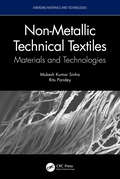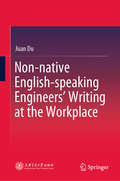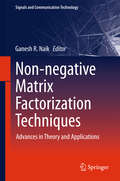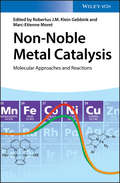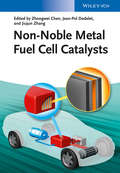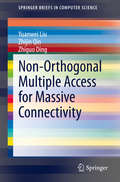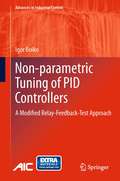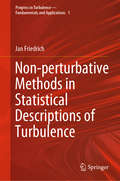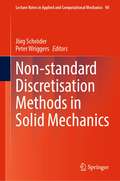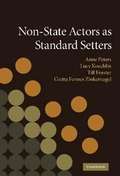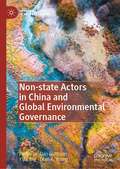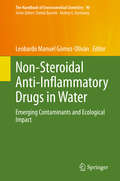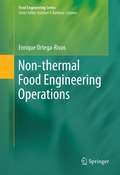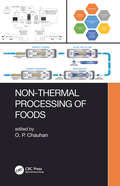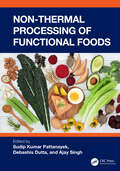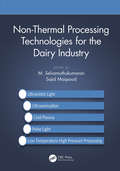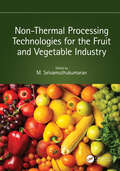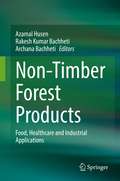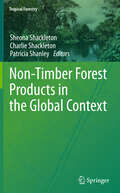- Table View
- List View
Non-Metallic Technical Textiles: Materials and Technologies (Emerging Materials and Technologies)
by Mukesh Kumar Sinha Ritu PandeyThis book describes various aspects of technical textiles and materials, emerging technologies, plant by-products, ultrafine fibers, functional fibers, and fabrics, covering the entire spectrum of technical textiles. It covers the fundamental aspects of emerging technology, materials, and processes. It also discusses various futuristic potential nanofibrous material spun via needleless technology and their inherent properties utilized for creating functional applications in the field of technical textiles.Features: Covers the fundamentals of technical fibers and their processing technologies. Explores natural fibers from agro-residue for high-value technical textiles. Presents up-to-date summary of technical textiles and associated technology. Highlights research and development studies data translated into product-oriented research and practical applications. Identifies the coloring ability of prevailing and new sources of pigments from bioresources. The book is aimed at researchers, professionals, and graduate students in textile and industrial engineering, materials science, and engineering, including apparel engineering.
Non-native English-speaking Engineers’ Writing at the Workplace
by Juan DuBased on 55 semi-structured in-depth interviews, this book investigates 15 high-tech engineering co-op professionals’ writing experience in the workplace. It shows how the digital age has had a marked impact on the engineers’ methods of communication at work, and how on-the -job writing has affected engineers’ technical competence, shaped their professional identities, challenged their views on Chinese and English writing, and hindered their success in the workplace. The book identifies three aspects of writing practice: engineers’ linguistic and literacy challenges, the reasons behind these challenges, and coping strategies, which suggest that engineers are underprepared and lack necessary support in the workplace. Lastly, the study shows that engineers need to engage in technical literacy through on-the-job writing so that they can fully deal with workplace discourse and socialize with diverse professional groups.Since the sample group interviewed in this book is engineers who studied at universities in the United States and have a foot in the world of school and work as well as knowledge of both Eastern and Western cultures, the book appeals to teachers, students, engineers and scientists who are interested in scientific and technological writing. It is also valuable for educators who prepare scientists, engineers, and technical communicators for professional roles, as well as for communication practitioners who work with engineers.
Non-negative Matrix Factorization Techniques
by Ganesh R. NaikThis book collects new results, concepts and further developments of NMF. The open problems discussed include, e. g. in bioinformatics: NMF and its extensions applied to gene expression, sequence analysis, the functional characterization of genes, clustering and text mining etc. The research results previously scattered in different scientific journals and conference proceedings are methodically collected and presented in a unified form. While readers can read the book chapters sequentially, each chapter is also self-contained. This book can be a good reference work for researchers and engineers interested in NMF, and can also be used as a handbook for students and professionals seeking to gain a better understanding of the latest applications of NMF.
Non-Noble Metal Catalysis: Molecular Approaches and Reactions
by Robertus J. Klein Gebbink Marc-Etienne MoretThis up-to-date review of this expanding field features conceptual chapters that provide readers with an overview of the specific principles and tools used in the development of molecular non-noble metal catalysts, such as the use of cooperative/redox non-innocent ligands, computational methods, and proton-coupled electron transfer (PCET) reactions. Reaction-specific chapters then typically focus on the use of non-noble metal catalysts in general or of one specific base metal for a specific reaction or highly related set of reactions. A must-have for researchers in the field of homogeneous catalysis and molecular synthesis, both in academia and in industry.
Non-Noble Metal Fuel Cell Catalysts
by Jiujun Zhang Zhongwei Chen Jean-Pol DodeletWritten and edited by top fuel cell catalyst scientists and engineers from both industry and academia, this is the first book to provide a complete overview of this hot topic. It covers the synthesis, characterization, activity validation and modeling of different non-noble metal electrocatalysts, as well as their integration into fuel cells and their performance validation, while also discussing those factors that will drive fuel cell commercialization.With its well-structured approach, this is a must-have for researchers working on the topic, and an equally valuable companion for newcomers to the field.
Non-Orthogonal Multiple Access for Massive Connectivity (SpringerBriefs in Computer Science)
by Yuanwei Liu Zhijin Qin Zhiguo DingThis book discusses non-orthogonal multiple access (NOMA) and the various issues in NOMA networks, including capability, sustainability, and security. This book starts from the basics and key techniques of NOMA. Subsequently, the authors discuss three critical issues in NOMA networks, including compatibility, sustainability, and security. Particularly, the authors first demonstrate the applications of NOMA in different networks including MIMO-NOMA, NOMA in heterogeneous networks, and NOMA in cognitive radio networks to show the compatibility of NOMA with various networks. Then the wireless powered NOMA networks are presented to address the sustainability issues in NOMA networks to extend the network reliability and lifetime. The security enhanced NOMA networks are discussed for single antenna case and multiple antenna case, respectively. Finally, the most recent developments on artificial intelligence (AI) enabled NOMA networks are discussed and the research challenges on NOMA to support massive number of devices are identified.
Non-parametric Tuning of PID Controllers
by Igor BoikoThe relay feedback test (RFT) has become a popular and efficient in process identification and automatic controller tuning. Non-parametric Tuning of PID Controllers couples new modifications of classical RFT with application-specific optimal tuning rules to form a non-parametric method of test-and-tuning. Test and tuning are coordinated through a set of common parameters so that a PID controller can obtain the desired gain or phase margins in a system exactly, even with unknown process dynamics. The concept of process-specific optimal tuning rules in the nonparametric setup, with corresponding tuning rules for flow, level pressure, and temperature control loops is presented in the text. Common problems of tuning accuracy based on parametric and non-parametric approaches are addressed. In addition, the text treats the parametric approach to tuning based on the modified RFT approach and the exact model of oscillations in the system under test using the locus of a perturbedrelay system (LPRS) method. Industrial loop tuning for distributed control systems using modified RFT is also described. Many of the problems of tuning rules optimization and identification with modified RFT are accompanied by MATLAB® code, downloadable from http://extras.springer.com/978-1-4471-4464-9 to allow the reader to duplicate the results. Non-parametric Tuning of PID Controllers is written for readers with previous knowledge of linear control and will be of interest to academic control researchers and graduate students and to practitioners working in a variety of chemical- mechanical- and process-engineering-related industries.
Non-perturbative Methods in Statistical Descriptions of Turbulence (Progress in Turbulence - Fundamentals and Applications #1)
by Jan FriedrichThis book provides a comprehensive overview of statistical descriptions of turbulent flows. Its main objectives are to point out why ordinary perturbative treatments of the Navier–Stokes equation have been rather futile, and to present recent advances in non-perturbative treatments, e.g., the instanton method and a stochastic interpretation of turbulent energy transfer. After a brief introduction to the basic equations of turbulent fluid motion, the book outlines a probabilistic treatment of the Navier–Stokes equation and chiefly focuses on the emergence of a multi-point hierarchy and the notion of the closure problem of turbulence. Furthermore, empirically observed multiscaling features and their impact on possible closure methods are discussed, and each is put into the context of its original field of use, e.g., the renormalization group method is addressed in relation to the theory of critical phenomena. The intended readership consists of physicists and engineers who want to get acquainted with the prevalent concepts and methods in this research area.
Non-standard Antennas
by François Le Chevalier Dominique Lesselier Robert StarajThis book aims at describing the wide variety of new technologies and concepts of non-standard antenna systems – reconfigurable, integrated, terahertz, deformable, ultra-wideband, using metamaterials, or MEMS, etc, and how they open the way to a wide range of applications, from personal security and communications to multifunction radars and towed sonars, or satellite navigation systems, with space-time diversity on transmit and receive. A reference book for designers in this lively scientific community linking antenna experts and signal processing engineers.
Non-standard Discretisation Methods in Solid Mechanics (Lecture Notes in Applied and Computational Mechanics #98)
by Jörg Schröder Peter WriggersThis edited volume summarizes research being pursued within the DFG Priority Programme 1748: "Reliable Simulation Methods in Solid Mechanics. Development of non-standard discretisation methods, mechanical and mathematical analysis", the aim of which was to develop novel discretisation methods based e.g. on mixed finite element methods, isogeometric approaches as well as discontinuous Galerkin formulations, including a sound mathematical analysis for geometrically as well as physically nonlinear problems. The Priority Programme has established an international framework for mechanical and applied mathematical research to pursue open challenges on an inter-disciplinary level. The compiled results can be understood as state of the art in the research field and show promising ways of further research in the respective areas. The book is intended for doctoral and post-doctoral students in civil engineering, mechanical engineering, applied mathematics and physics, as well as industrial researchers interested in the field.
Non-State Actors as Standard Setters
by Anne Peters Lucy Koechlin Till Förster Gretta Fenner ZinkernagelThis analysis of 'globalised' standard-setting processes draws together insights from law, political sciences, sociology and social anthropology to assess the authority and accountability of non-state actors and the legitimacy and effectiveness of the processes. The essays offer new understandings of current governance problems, including environmental and financial standards, rules for military contractors and complex public-private partnerships, such as those intended to protect critical information infrastructure. The contributions also evaluate multi-stakeholder initiatives (such as the Extractive Industries Transparency Initiative), and discuss the constitution of public norms in stateless areas. A synopsis of the latest results of the World Governance Indicator, arguably one of the most important surveys in the area today, is included.
Non-state Actors in China and Global Environmental Governance (Governing China in the 21st Century)
by Dan Guttman Yijia Jing Oran R. YoungThis book is the first effort to develop a broad and deep perspective on the emerging space occupied by “non-state actors” in China in the context of global environmental governance. It will serve as a primer both for scholars seeking to understand China’s environmental governance system and for practitioners working with policymakers and administrators within that system. Individual chapters explore what works in achieving social change, domestically as well as globally, and will provide guidance to activists and directors of NGOs as well as scholars.
Non-Steroidal Anti-Inflammatory Drugs in Water: Emerging Contaminants and Ecological Impact (The Handbook of Environmental Chemistry #96)
by Leobardo Manuel Gómez-OlivánThis book gathers the main international research findings on non-steroidal anti-inflammatory drugs (NSAIDs) as emerging contaminants in water. It focuses on the major routes of exposure, and the destinations and life cycles of NSAIDs in water, as well as the manifestations of toxicity in different organisms. It also reviews the methods used in the detection, analysis and quantification of NSAIDs in water as well as the biological and chemical methods of removing them. Lastly, the book offers an overview of the legal frameworks in place and provides conclusions and recommendations for the future. Given its scope, the book is an indispensable resource for scientists in academia and industry, as well as for decision-makers involved in contamination assessment and environmental analysis and NGOs interested in the problem of water contamination by NSAIDs.
Non-thermal Food Engineering Operations
by Enrique Ortega-RivasA number of food engineering operations, in which heat is not used as a preserving factor, have been employed and are applied for preparation (cleaning, sorting, etc.), conversion (milling, agglomeration, etc.) or preservation (irradiation, high pressure processing, pulsed electric fields, etc.) purposes in the food industry. This book presents a comprehensive treatise of all normally used food engineering operations that are carried out at room (or ambient) conditions, whether they are aimed at producing microbiologically safe foods with minimum alteration to sensory and nutritive properties, or they constitute routine preparative or transformation operations. The book is written for both undergraduate and graduate students, as well as for educators and practicing food process engineers. It reviews theoretical concepts, analyzes their use in operating variables of equipment, and discusses in detail different applications in diverse food processes.
Non-thermal Processing of Foods
by O. P. ChauhanThis book presents the latest developments in the area of non-thermal preservation of foods and covers various topics such as high-pressure processing, pulsed electric field processing, pulsed light processing, ozone processing, electron beam processing, pulsed magnetic field, ultrasonics, and plasma processing. Non-thermal Processing of Foods discusses the use of non-thermal processing on commodities such as fruits and vegetables, cereal products, meat, fish and poultry, and milk and milk products. <P><P>Features: <li>Provides latest information regarding the use of non-thermal processing of food products <li>Provides information about most of the non-thermal technologies available for food processing <li>Covers food products such as fruits and vegetables, cereal products, meat, fish and poultry, and milk and milk products <li>Discusses the packaging requirements for foods processed with non-thermal techniques <P><P>The effects of non-thermal processing on vital food components, enzymes and microorganisms is also discussed. Safety aspects and packaging requirements for non-thermal processed foods are also presented. Rounding out coverage of this technology are chapters that cover commercialization, regulatory issues and consumer acceptance of foods processed with non-thermal techniques. The future trends of non-thermal processing are also investigated. <P><P>Food scientists and food engineers, food regulatory agencies, food industry personnel and academia (including graduate students) will find valuable information in this book. Food product developers and food processors will also benefit from this book.
Non-Thermal Processing of Functional Foods
by Sudip Kumar Pattanayek, Debashis Dutta, and Ajay SinghFunctional foods, also known as nutraceuticals, began to gain prominence in the 1980s in Japan as “foods for specified health use” and became more widely recognized in the 1990s as research and interest in foods that could provide specific health benefits beyond essential nutrition grew worldwide. These foods are typically enriched with bioactive components or formulated to contain substances or live microorganisms with a possible health-enhancing or disease-preventing value and at a safe and sufficiently high concentration to achieve the intended benefit.Usually, the added ingredients are classified as nutrients, dietary fiber, phytochemicals, other substances, or probiotics. The production, storage, and consumer consumption of these functional foods require special attention to preserve quality attributes. The production process of these foods can be classified as conventionally used thermal processing methods and non-thermal alternatives. In addition, these processes may be combined with biological approaches involving enzymatic treatment and fermentation. The various non-thermal processes, such as ultrasounds, high-hydrostatic pressure, vacuum impregnation, high-voltage electrical discharge, cold plasma, pulsed light, ozonation, etc., can be utilized for a product to sustain/preserve quality attributes of the ingredients, long shelf life, and sensory qualities.This book compiles the latest non-thermal processing technologies to develop functional foods. The book discusses bioactivity, bioaccessibility, and bioavailability related to nutrition and functional food ingredients. It has 16 articles on different aspects of non-thermal processing technologies. Chapter 1 has discussed a general overview of emerging technologies, and various non-thermal processing techniques are discussed in Chapters 2–6, 8–9, and 12. Chapters 7, 11, 13, 15, and 16 discuss food safety and preservation. We have discussed the functional foods and bioactive compounds in Chapters 10 and 14. A few of these reviews discuss the impact of developing non-thermal technologies on several food components (proteins, carbohydrates, lipids, minerals, vitamins, polyphenols, glucosinolates, fragrance compounds, and enzymes) while maintaining the structure and functional properties.This book is an excellent source of information for professionals, postgraduate students, and researchers in food sciences and chemical engineering.
Non-Thermal Processing Technologies for the Dairy Industry
by M. Selvamuthukumaran and Sajid MaqsoodThe dairy industry usually adopts conventional methods of processing various milk-based food products, which can destroy nutrients and minimize organoleptic qualities. An alternative approach for this is the non-conventional method of non-thermal processing techniques. Not only does this enhance the nutritional profile of the various processed products, but increases the consumer acceptability. There are some emerging non-thermal processing techniques such as pulsed light, cold plasma, high pressure processing, ultrasonic, UV pasteurization, or ozone treatments, which can be successfully employed in dairy processing industries to enhance product acceptability, safety, and quality aspects. Non-Thermal Processing Technologies for the Dairy Industry describes several emerging non-thermal processing techniques that can be specially employed for the dairy processing industry. The book narrates the benefits of using pulsed light, cold plasma, high pressure and ultrasonic during processing of various dairy products. Key Features: Addresses techniques used for extraction of functional food components from various dairy products by using super critical CO2 extraction technology. Explains application of ozone and cold plasma technology for treating dairy processing waste waters with efficient recycling aspects. Discusses the importance of using biopreservatives in shelf life extension of several dairy food products. Portrays scope and significant importance of adopting UV pasteurization in processing market milk along with safety and environmental impacts over processing This book solves the issue of waste generation in dairy industries and further advises recovery of such waste for efficient recycling process. In addition to being useful for dairy technologists, it is a great source for academic scholars and students looking to gain knowledge and excel in the non-thermal procesing area.
Non-Thermal Processing Technologies for the Fruit and Vegetable Industry
by M. SelvamuthukumaranFruits and vegetables rapidly spoil due to growth of microorganisms, which further render them unsafe for human consumption. The traditional methods of food preservation, which involves drying, canning, salting, curing, and chemical preservation, can significantly affect food quality by diminishing nutrients during heat processing. This can alter the texture of the products, leave chemical residues in the final processed products, which in turn has greater impact over consumers' safety and health concerns. To combat this problem, various current non-thermal food processing techniques can be employed in fruit and vegetable processing industries to enhance consumer satisfaction for delivering wholesome food products to the market, thus increasing demand. Non-Thermal Processing Technologies for the Fruit and Vegetable Industry introduces the various non-thermal food processing techniques especially employed for fruits and vegetables processing industries; it deals with the effect of several non-thermal processing techniques on quality aspects of processed fruits and vegetable products and keeping quality and consumer acceptability. Key Features: Describes the high-pressure processing techniques employed for processing fruit and vegetable based beverages Discusses the safety aspects of using various innovative non-thermal based technologies for the fruits and vegetables processing industries. Explains ozone application, cold plasma, ultrasound and UV irradiation for fruits and vegetables with their advantages, disadvantages, process operations, mechanism for microbes in activation etc. Presents the commercially viable and economically feasible non-thermal processing technologies for fruit and vegetable industry. This book addresses professors, scientists, food engineers, research scholars, students and industrial personnel for stability enhancement of fruit- and vegetable-based food products by using novel non-thermal food processing techniques. Readers will come to know the current and emerging trends in use of non-thermal processing techniques for its application in several fruit- and vegetable-based food processing industries.
Non-Thermal Processing Technologies for the Grain Industry
by M. SelvamuthukumaranFood can rapidly spoil due to growth of microorganisms, and traditional methods of food preservation such as drying, canning, salting, curing, and chemical preservation can affect the quality of the food. Nowadays, various non-thermal processing techniques can be employed in grain processing industries to combat this. They include pulsed electric field processing, high pressure processing, ultrasonic processing, cold plasma processing, and more. Such techniques will satisfy consumer demand for delivering wholesome food products to the market. Non-Thermal Processing Technologies for the Grain Industry addresses these many new non-thermal food processing techniques that are used during grain processing and minimize microbial contamination and spoilage. Key Features: Explains the mechanism involved in application of cold plasma techniques for grain processing, and its strategy for inactivation of microbes by using this technique Deals with the effect of incorporation of electric pulses on quality aspects of various grain based beverage products. Details the innovative high pressure processing techniques used for extraction of antioxidant from food grains Explores the safety issues and applications of non-thermal food processing techniques This book will benefit food scientists, food process engineers, academicians, students, as well as anyone else in the food industry by providing in-depth knowledge and emerging trends about non-thermal processing techniques in various grain-based food processing industries.
Non-Thermal Processing Technologies for the Meat, Fish, and Poultry Industries
by M. Selvamuthukumaran Sajid MaqsoodProcessed products obtained from meat, fish, and poultry play a predominant role ascribed to their nutritional profile and sensory characteristics. Usually, these products are highly perishable, and, therefore, the food industry used traditional thermal methods of heat processing in order to extend the stability of the product to the greatest extent. But this traditional method has several disadvantages including undesirable changes in organoleptic characteristics, denaturation of the good quality of animal proteins, and degradation of several nutritional components. Non-Thermal Processing Technologies for the Meat, Fish, and Poultry Industries addresses stability enhancement of meat-, fish-, and poultry-processed products by implementing a non-thermal approach. Currently, there are several innovative non-thermal processing techniques available that can be adopted for enhancing the safety quality of these foods. This book presents the various non-thermal processing techniques that can be successfully applied to this processing industry, including high-pressure processing, ultrasound, irradiation, and pulse electric fields. It explains how these processes can signifantly minimize quality changes without posing any threat to the consumer. These techniques can be replaced for traditional thermal processing techniques viz. roasting, frying, boiling, and grilling. This book benefits food scientists, food process engineers, academicians, students, and food industrial professionals by providing in-depth knowledge of non-thermal processing of foods for meat, fish, and poultry product quality retention as well as for efficient consumer acceptability. The text contains current and emerging trends in the use of non-thermal processing techniques for its application in these industries.
Non-Thermal Technologies for the Food Industry: Advances and Regulations
by C. Anandharamakrishnan V. R. Sinija R. MahendranDepending on the mechanisms involved in non-thermal technologies (such as ozonization, irradiation, ultrasound processing, plasma processing, and advanced oxidative processes), interaction with food molecules differs, which might lead to desirable reactions. Non-Thermal Technologies for the Food Industry: Advances and Regulations explores the possibility of using non-thermal technologies for various purposes such as shelf-life extension, reduced energy consumption, adhesion, and safety improvement. Further, it reviews the present status of these technologies, international regulations, and sustainability aspects in food processing including global case studies.Features: Provides a comprehensive overview of all the non-thermal processing technologies that have potential for use within food manufacturing Covers novel disinfectant technologies and packaging methods for non-thermal processing Includes electro-spraying and electrospinning; low-temperature drying techniques, cold plasma techniques, hydrodynamic cavitation, oscillating magnetic field processing, and so forth Focus on topics such as the valorization of agri-food wastes and by-products and sustainability Reviews ClO2 in combined/hybrid technologies for food processing This book is aimed at researchers and graduate students in food and food process engineering.
Non-Timber Forest Products: Food, Healthcare and Industrial Applications
by Azamal Husen Rakesh Kumar Bachheti Archana BachhetiForests cover thirty-one percent of the world’s land surface, provide habitats for animals, livelihoods for humans, and generate household income in rural areas of developing countries. They also supply other essential amenities, for instance, they filter water, control water runoff, protect soil erosion, regulate climate, store nutrients, and facilitate countless non-timber forest products (NTFPs). The main NTFPs comprise herbs, grasses, climbers, shrubs, and trees used for food, fodder, fuel, beverages, medicine, animals, birds and fish for food, fur, and feathers, as well as their products, like honey, lac, silk, and paper. At present, these products play an important role in the daily life and well-being of millions of people worldwide. Hence the forest and its products are very valuable and often NTFPs are considered as the ‘potential pillars of sustainable forestry’. NTFPs items like food, herbal drugs, forage, fuel-wood, fountain, fibre, bamboo, rattans, leaves, barks, resins, and gums have been continuously used and exploited by humans. Wild edible foods are rich in terms of vitamins, protein, fat, sugars, and minerals. Additionally, some NTFPs are used as important raw materials for pharmaceutical industries. Numerous industry-based NTFPs are now being exported in considerable quantities by developing countries. Accordingly, this sector facilitates employment opportunities in remote rural areas. So, these developments also highlight the role of NTFPs in poverty alleviation in different regions of the world. This book provides a wide spectrum of information on NTFPs, including important references. We hope that the compendium of chapters in this book will be very useful as a reference book for graduate and postgraduate students and researchers in various disciplines of forestry, botany, medical botany, economic botany, ecology, agroforestry, and biology. Additionally, this book should be useful for scientists, experts, and consultants associated with the forestry sector.
Non-Timber Forest Products in the Global Context
by Charlie Shackleton Patricia Shanley Sheona ShackletonThis book provides a comprehensive, global synthesis of current knowledge on the potential and challenges associated with the multiple roles, use, management and marketing of non-timber forest products (NTFPs). There has been considerable research and policy effort surrounding NTFPs over the last two and half decades. The book explores the evolution of sentiments regarding the potential of NTFPs in promoting options for sustainable multi-purpose forest management, income generation and poverty alleviation. Based on a critical analysis of the debates and discourses it employs a systematic approach to present a balanced and realistic perspective on the benefits and challenges associated with NTFP use and management within local livelihoods and landscapes, supported with case examples from both the southern and northern hemispheres. This book covers the social, economic and ecological dimensions of NTFPs and closes with an examination of future prospects and research directions.
Non-Traditional and Advanced Machining Technologies: Machine Tools and Operations
by Helmi Youssef Hassan El-HofyNon-Traditional and Advanced Machining Technologies covers the technologies, machine tools, and operations of non-traditional machining processes and assisted machining technologies. Two separate chapters deal with the machining techniques of difficult-to-cut materials, such as stainless, super alloys, ceramics, and composites. Design for machining, accuracy and surface integrity of machined parts, environment-friendly machine tools and operations, and hexapods are also presented. The topics covered throughout reflect the rapid and significant advances that have occurred in various areas in machining technologies and are organized and described in such a manner to draw the interest of the reader. The treatments are aimed at motiving and challenging the reader to explore viable solutions to a variety of questions regarding product design and optimum selection of machining operations for a given task. The book will be useful to professionals, students, and companies in the areas of industrial, manufacturing, mechanical, materials, and production engineering fields.
Non-Traditional Feeds for Use in Swine Production (CRC Press Revivals)
by Phillip A Thacker Roy N KirkwoodFeed represents the single greatest expense associated with bringing pigs to market weight. Therefore, if you can reduce the cost of feeding without detriment to pig performance, the economics of swine production will improve. The ingredient list for swine rations has become fairly limited, and the majority of diets fed to pigs consist of a few staples, such as corn, wheat, barley, and soybean meal. Non-Traditional Feeds for Use in Swine Production explores over fifty non-traditional feedstuffs in terms of their nutritional content and their viability as alternative, cost effective food sources
